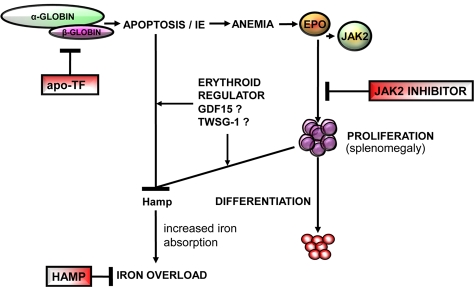Figure 6.
Overview of the pathophysiology of β-thalassemia. This disease is a consequence of insufficient β-globin synthesis, leading to excess heme and α-globin, apoptosis, and anemia. Anemia results from a block of erythroid differentiation, although erythroid proliferation is increased, resulting in IE, hepcidin suppression, and iron overload. The novel therapies discussed in this review, apo-transferrin (apo-Tf), JAK2 inhibitors, and hepcidin agonists (HAMP), have the potential to affect different steps in the pathophysiology of this disease. Furthermore, studies in β-thalassemia might provide information to further understand the physiology of normal erythropoiesis.

